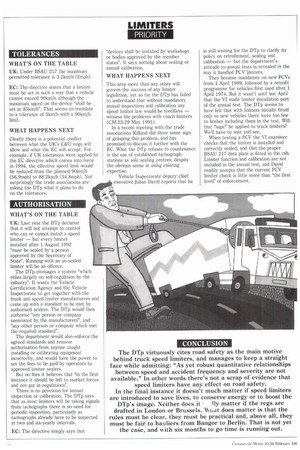AUTHORISATION
Page 44

If you've noticed an error in this article please click here to report it so we can fix it.
WHAT'S ON THE TABLE UK: Last year the DTp declared that it will not attempt to control who can or cannot install a speed limiter — but every limiter installed after 1 August 1992 "must be sealed by a person approved by the Secretary of State". Running with an un-sealed limiter will be an offence,
The DTp envisages a system "which relies largely on self-regulation by the industry". It wants the Vehicle Certification Agency and the Vehicle Inspectorate to get together with the truck and speed limiter manufacturers and come up with a standard to be met by authorised sealers. The DTp would then authorise "any person or company nominated by the manufacturers", and "any other person or company which met the required standard".
The department would also enforce the agreed standards and remove authorisation from anyone caught installing or calibrating equipment incorrectly, and would have the power to set the fees to be paid by operators to approved limiter sealers.
But on fees it believes that "in the first instance it should be left to market forces and not put in regulations.
There is no provision for annual inspection or calibration. The DTp says that as most limiters will be taking signals from tachographs there is no need for periodic inspection, particularly as tachographs already have to be inspected at two and six-yearly intervals.
EC: The directive simply says that "devices shall be installed by workshops or bodies approved by the member states". It says nothing about sealing or annual calibration.
WHAT HAPPENS NEXT This area more than any other will govern the success of any limiter legislation, yet so far the DTp has failed to understand that without mandatory annual inspections and calibration any speed limiter law would be toothless — witness the problems with coach limiters (CM 23-29 May 1991).
In a recent meeting with the trade associations Rifkind did show some sign of grasping this problem, and has promised to discuss it further with the EC. What the DTp refuses to countenance is the use of established tachograph stations as sole sealing centres, despite the obvious sense in using existing expertise.
Vehicle Inspectorate deputy chief executive Julian David reports that he is still waiting for the DTp to clarify its policy on retrofitment, sealing and calibration — but the department's attitude to annual tests is revealed in the way it handled PCV limiters.
They became mandatory on new PCVs from 1 April 1989, followed by a retrofit programme for vehicles first used after 1 April 1974. But it wasn't until last April that the VI made limiter installation part of the annual test. The DTp seems to have felt that with limiters initially fitted only to new vehicles there were too few to bother including them in the test. Will that "logic" be applied to truck limiters? We'll have to wait and see.
When testing a PCV the VI examiner checks that the limiter is installed and correctly sealed, and that the proper BSAU 217 data plate is fitted in the cab. Limiter function and calibration are not included in the annual test, and David readily accepts that the current PCV limiter check is little more than "the first level" of enforcement.




















































































